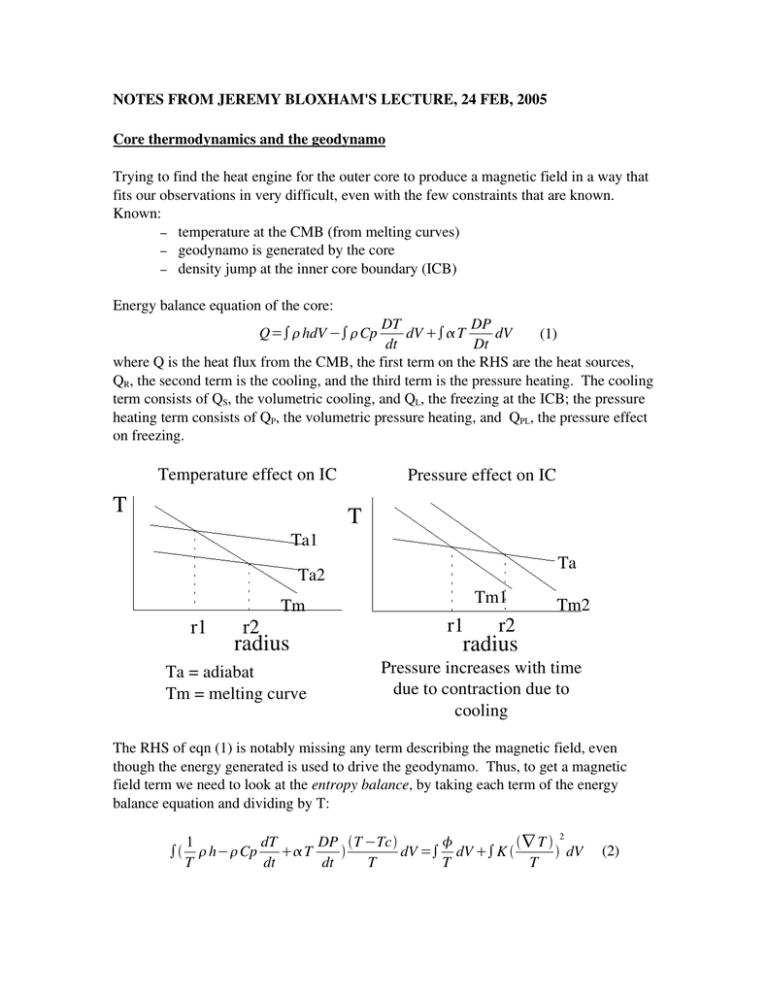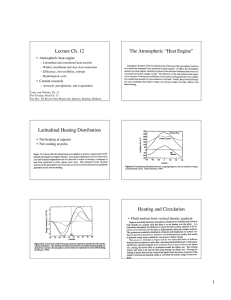NOTES FROM JEREMY BLOXHAM'S LECTURE, 24 FEB, 2005 Core thermodynamics and the geodynamo Trying to find the heat engine for the outer core to produce a magnetic field in a way that
advertisement

NOTES FROM JEREMY BLOXHAM'S LECTURE, 24 FEB, 2005 Core thermodynamics and the geodynamo Trying to find the heat engine for the outer core to produce a magnetic field in a way that fits our observations in very difficult, even with the few constraints that are known. Known: – temperature at the CMB (from melting curves) – geodynamo is generated by the core – density jump at the inner core boundary (ICB) Energy balance equation of the core: DT DP dV ∫ T dV (1) dt Dt where Q is the heat flux from the CMB, the first term on the RHS are the heat sources, QR, the second term is the cooling, and the third term is the pressure heating. The cooling term consists of QS, the volumetric cooling, and QL, the freezing at the ICB; the pressure heating term consists of QP, the volumetric pressure heating, and QPL, the pressure effect on freezing. Q=∫ hdV −∫Cp Temperature effect on IC T Pressure effect on IC T Ta1 Ta Ta2 r1 r2 Tm radius Ta = adiabat Tm = melting curve Tm1 r1 r2 Tm2 radius Pressure increases with time due to contraction due to cooling The RHS of eqn (1) is notably missing any term describing the magnetic field, even though the energy generated is used to drive the geodynamo. Thus, to get a magnetic field term we need to look at the entropy balance, by taking each term of the energy balance equation and dividing by T: ∫ 1 dT DP T −Tc ∇ T 2 h−Cp T dV =∫ dV ∫K dV (2) T dt dt T T T The LHS describes the entropy changes due to heat sources. The term (T­Tc)/T is the efficiency factor. The first term of the RHS is E, the ohmic and viscous dissipation, and the second term is EK, K the thermal conductivity (diffusion term). From both equations (1) and (2), we get the simplified form: Q = QR + QS + QL + QP + QPL = Ah + B dTc dt (3) where A is the internal heating and the second term is the rate of change of the temperature at the CMB. Similarly, EK + E = ER + ES + EL + EP + EPL = Ch + D dTc (4) dt EK can be estimated and is in the range of 200 – 500 MW/K. E is given by the following relation: J2 dV E = ∫ T (5) Various estimates are: 0.2 MW/K (Christensen) 40 MW/K (Kunang & Bloxham) 400 MW/K (Roberts, James, & Calderwood) To derive the dynamo thermally we need entropy of 1000 MW/K. The problem is investigated from two end­member situations: dTc = 0 dt 2) No internal heating: h = 0 1) No cooling: For the first case of no cooling, Q = 31.4 TW, which is 75% of the total heat flux of the earth, and requires h = 16 x 10­12 W/kg. QK = 8.6 TW, conduction up the adiabat. This is not a realistic situation, for 75% of the earth's heat flow to come from the core. For the second case, Q = 20.5 TW, which is 50% of the total heat flux, a more reasonable estimate but still unlikely. In addition, if no internal heating of the core is assumed, the age of the inner core is only 254 Ma. Once the cooling effect of the inner core is removed, the heat flow becomes Q = 28.8 TW and the cooling rate becomes very large, 565 K/Ga, which leads to a “thermal disaster” in earth's earlier history. Take home message: it's very hard to run a thermally driven dynamo. If we try to drive the dynamo by thermal convection, it will lose most of the heat before it does much for the dynamo. Therefore, see if chemical variations do a better job of driving the geodynamo: To maintain the entropy requirement for dynamo, we need to maintain the convection Q = 8.6 TW (Cooling) at the rate of 70 K /Gyr = 12.5 TW (Heating) This will give the age of inner core to be 638 Myr (too young!) Suggestion: To check the effect of trace elements on entropy balance Inner core: (Fe + Ni) + (8% Si/S) Outer core: Fe + 8% S/Si + 8% O Qg : gravitational rearrangement of oxygen in the outer core QH: Change in the internal energy from gradual dilution of outer core with oxygen LHS of entropy balance Eα: Dissipation associated with molecular diffusion Eg: Entropy of gravitational energy relaease Main Conclusions and Discussion: 50% of entropy requirement comes from gravitational energy changes caused by expulsion of oxygen at ICB with only 15% of heat flux Inner core is 300 – 1800 Myr old To make it more old (3.5 Gyrs) we need to add some heat sources, probably potassium. Adding potassium can satisfy following: Present day inner core Heat Flux (20% from core) Mantle temperature + Cooling Sufficient Entropy Production NOTE: (1) There was discussion on incorporation of potassium in the core… Stein Jacobsen suggested incorporating 300 ppm of potassium is not possible from geochemistry point of view (200 ppm may be possible). There are high pressure results that around 1200 ppm of potassium can be alloyed with Iron (1/10 of 1%) (2) Incorporation of other elements like xenon and magnesium into iron may have some effect on total entropy balance. (3) Viscosity has small contribution on dissipation term. So the main contribution is from ohimic.




